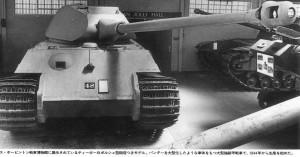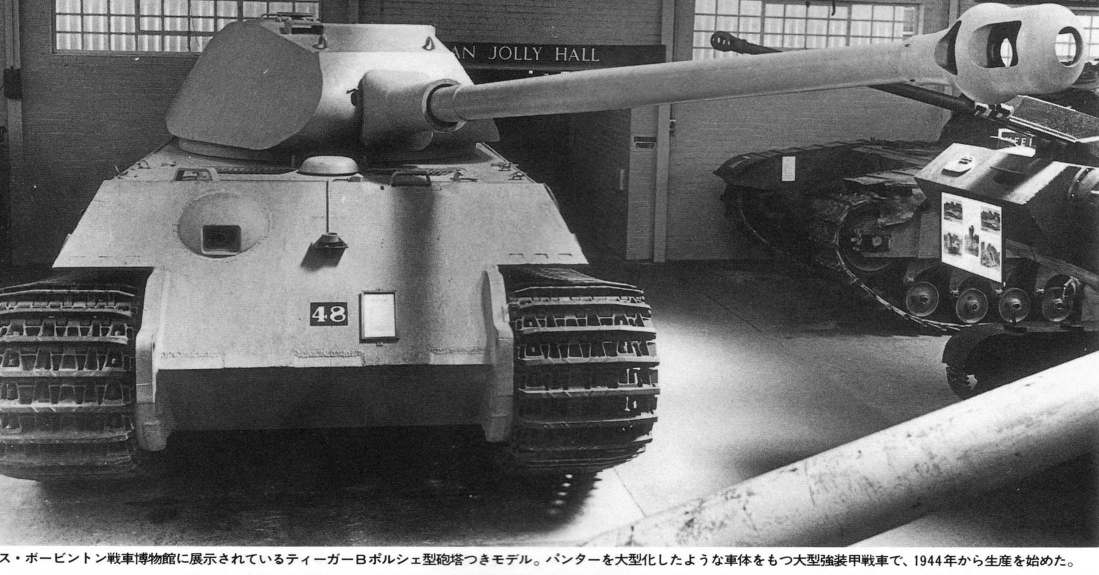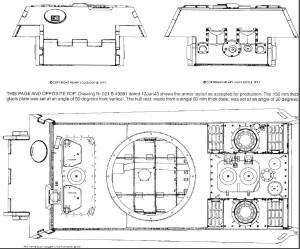Henschel prototype VK4503 Tiger III
The VK45.03 was a prototype of Tiger II. Henschel entered into the race for a new german heavy tank only on 5 March 1942. The first project was a VK45.01 (H) armed with a 8.8 cm KwK L/56. Soon there was a second project, the VK45.02 (H) armed with a 7.5cm KwK l/70. Only on april 1942 there was the first attempt to build a prototype armed with a 8.8cm KwK L/71. This project was designed VK45.03 (H). But in February 1943 this concept tank was redesigned in order to use as many standardized parts as possible (from Panther and Panther II).
Il VK45.03 era un prototipo di Tiger II. Henschel entrò nella gara per un nuovo carro armato pesante tedesco solo il 5 marzo 1942. Il primo progetto è fu quello di un VK45.01 (H) armato di un cannone da 8.8 centimetri KwK L / 56. Ben presto ci fu un secondo progetto, il VK45.02 (H) armato di un cannone da 7.5 centimetri KwK l/70. Solo nell’aprile 1942 ci fu il primo tentativo di costruire un prototipo armato con un 8.8 centimetri KwK L/71. Questo progetto è stato concepito come VK45.03 (H). Ma nel febbraio 1943 questo mezzo è stato riprogettato per utilizzare il maggior numero di parti standardizzate possibili (da Panther e Panther II).

Krupp designed the turrets for Vk45.02 P and 45.03 H. The main difference was the traverse drive, Porsche drive was electric, Henschel drive was hydraulic
Krupp progettò le torrette per il Vk45.02 P e il VK45.03 H. La differenza principale fu il motore di brandeggio, quello Porsche era elettrico, quello Henschel era idraulico
Here is the Henschel designations of Tiger II prototypes: VK 45.03 by 28.10.1942; Tiger III by 10.12.1942; Tiger 3 by 02.02.1943; Tiger II on 5.03.1943; Tiger 2 by 08.03.1943.
Ecco le designazioni Henschel dei prototipi del Tiger II: VK 45.03 dal 28/10/1942; Tiger III dal 10/12/1942; Tiger 3 dal 02/02/1943; Tiger II dal 03/05/1943; Tiger 2 dal 03/08/1943.
It is worth remembering that Henschel proposed many sketches of the VK45.03, the first (HSK Nr. J3018) was ready on 19 October 1942. In this sketch Henschel showed the proposal of roadwheel layout: four rubber-tired roadwheels per axle running on a 76cm wide track. A new layout with steel-tired rubber cushioned roadwheels was proposed on 17 January 1943 (sketch HSK Nr. J3198). On 25 november 1942 a new sketch was prepared (HSK Nr. J3104), showing front and rear armor thickness. Henschel proposed a 100mm/50° thick front upper plate and 100mm/50° thick lower hull plate, 80mm/30° for sides (superstructure), 80mm/0° hull sides. The rear protection was to be 80mm thick at 30°. following a Speer’s conference with Hitler (3 January 1943), Henschel prepared a new schetch (HSK Nr. J3168) with a redesigned VK45.03 “Bug mit verstaerkte Stirnwand”. Hull and chassis of VK45.03 were strengthened. The glacis plate was increased to 150mm/50° and the protective ring segment for the final drives was increased to 100mm (from 80mm). The final drawings for Vk45.03 approved by Wa Pruef 6 was the 021 St 49501. In this drawings every component was redesigned or modified to speed up the production. It was necessary to share components from and for Panther Ausf G and Panther II.
Source – Jentz, Thomas; Doyle, Hilary (1997). Germany’s Tiger Tanks – Vk45 to Tiger II: Design, Production & Modifications. West Chester: Schiffer Publishing, pages 13-16; “Tamiya News” German WWII tanks in world museums. Vol1.
Vale la pena ricordare che la Henschel propose molti abbozzi del VK45.03, il primo (HSK Nr J3018.) era pronto il 19 ottobre 1942. In questo abbozzo Henschel mostrò la proposta di layout per il treno di rotolamento: quattro ruote di gomma per asse in esecuzione su cingoli larghi 76 centimetri. Un nuovo layout con ruote di acciaio gommato e ammortizzato venne proposto per il 17 Gennaio 1943 (schizzo HSK Nr. J3198). Il 25 Novembre 1942 un nuovo disegno venne preparato (HSK Nr. J3104), mostrando lo spessore anteriore e posteriore della corazza. Henschel propose una piastra superiore frontale spessa 100mm / 50° e 100 mm / 50° per la piastra inferiore frontale dello scafo, 80 millimetri / 30° per i lati (sovrastruttura), e 80 millimetri / 0 ° per lo scafo. La protezione posteriore doveva essere di 80 millimetri di spessore a 30°. In seguito ad una conferenza di A. Speer con Hitler (3 gennaio 1943), Henschel preparò una nuova bozza (HSK Nr. J3168) con un VK45.03 “Bug mit verstaerkte Stirnwand” riprogettato. Scafo e telaio del VK45.03 vennero rafforzati. La piastra inclinata superiore venne aumentata a 150mm / 50° di spessore e l’anello protettivo per i riduttori finali venne aumentato a 100mm (da 80mm). I disegni finali per Vk45.03 approvati dal Wa Pruef 6 furono quelli denominati 021 S. 49501. In questi disegni ogni componente venne riprogettato o modificato per accelerare la produzione. Fu necessario condividere componenti da e per il Panther Ausf G e Panther II.



